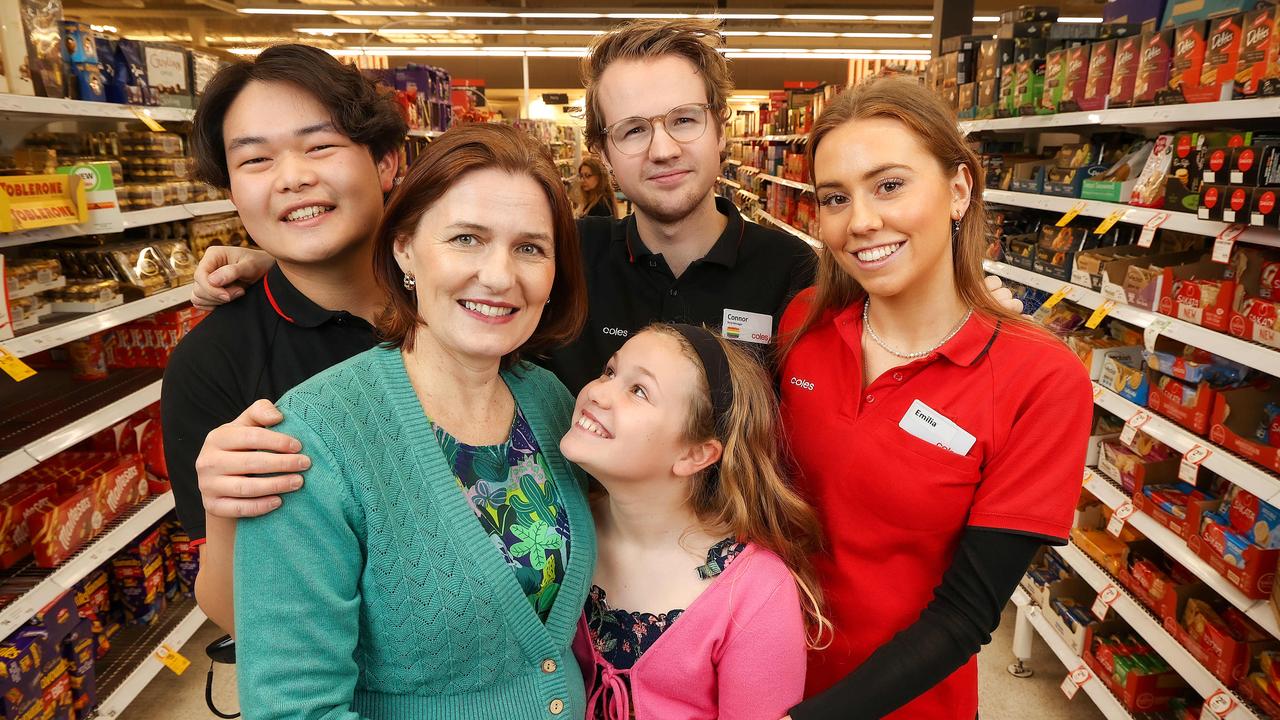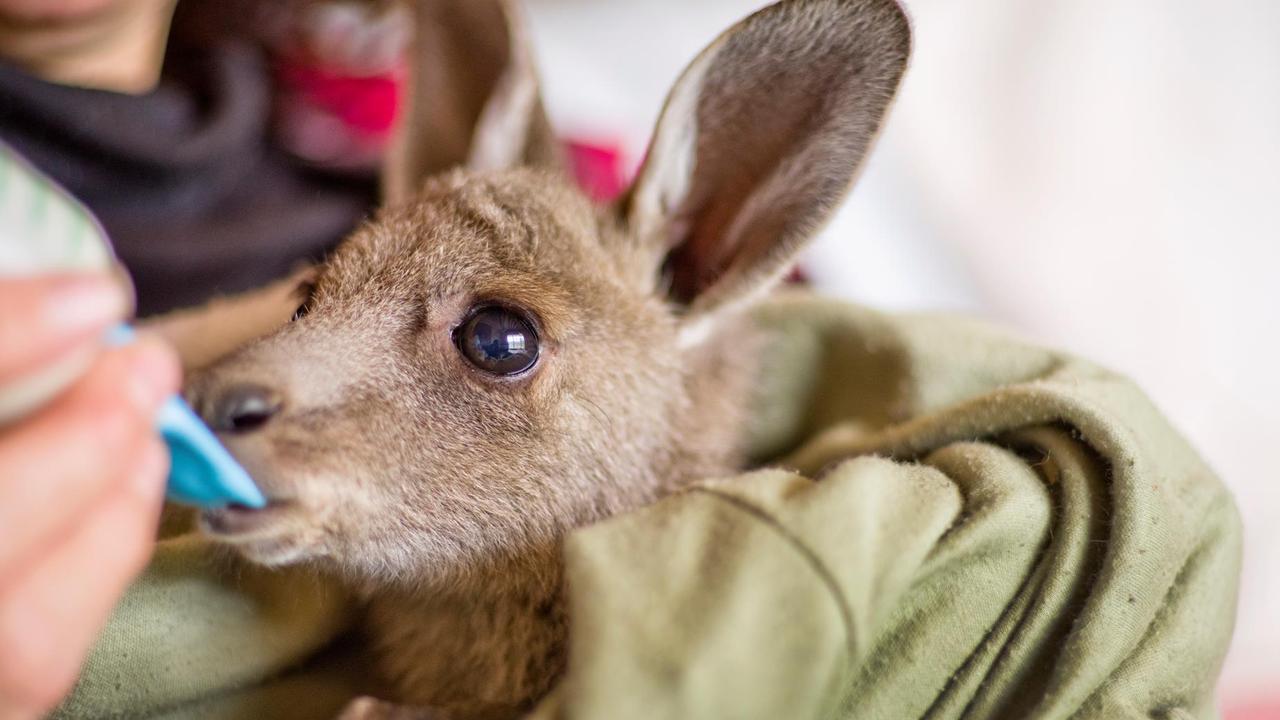Winning friends and influencing people
WE speak to 25 influential industry movers and shakers who have shaped and helped create our hospitality landscape.
VIC News
Don't miss out on the headlines from VIC News. Followed categories will be added to My News.
- Eat your way around the world
- River Graze
- Victoria’s food and wine festivals
- Could Brae make World’s 50 Best list?
Please take a seat, unfurl your napkin and raise a glass to Victoria’s food and drink innovators. With the Melbourne Food and Wine Festival in full swing for its 25th anniversary year, we speak to 25 influential industry movers and shakers who have irrevocably shaped and helped create the hospitality landscape we enjoy today.
HUXTABURGER
Burger biz
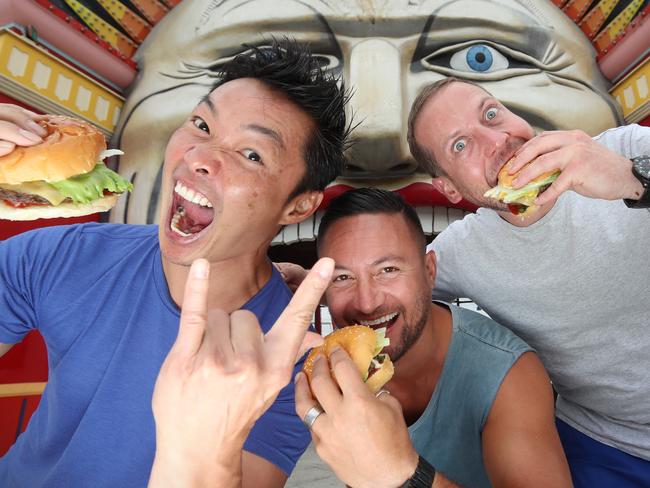
HUXTABURGER led the charge for the gourmet burger buns we devour today. Owners Daniel Wilson, Dante Ruaine and Jeff Wong opened their first site on Collingwood’s Smith St in 2011 as a spin-off to alleviate quiet lunch times at Huxtable, their restaurant across the road. As the burger biz boomed, they closed Huxtable and have expanded Huxtaburger into the city, Prahran, Hawthorn, Eastland (Ringwood) and the inner west by mid year. The next move is franchising, with 50 stores planned nationally over five years. The schtick remains — a retro diner fitout (but rebranding is imminent), crinkle-cut chips, good beer, and burgers name-checking The Cosby Show characters, including the Huxtaburger with its brioche bun and wagyu patty. This cult bun sparked a citywide obsession and an enduring food fad. In a market stacked with burgers, including chains from fine-dining chefs Neil Perry and soon Shannon Bennett, this trio paved the way for a new burger joint to open — and thrive — seemingly every month.
Most memorable dishes from the past 25 years?
Chef Daniel Wilson: “Paul Wilson’s tuna with wasabi custard and soy at The Botanical, Victorian crayfish with egg noodles and Peking duck at Flower Drum, Aaron Turner’s suckling pig at Loam, Frank Camorra’s anchovy with smoked tomato sorbet at MoVida, and Philippa Sibley’s white peach and almond clafoutis at Luxe.”
What’s holding the industry back?
“A lack of staff, especially chefs, is one of the major problems I hear from industry pals. Also, the high wages and penalty rates makes for small margins in our very competitive industry.”
What does the next 25 years hold?
“I hope food education for our children will increase, along with the amount of wholefoods eaten to reduce the number of processed/convenient products. People need to connect more with where their food comes from, rather than simply relying on a supermarket shelf. Also being more morally conscious by reducing both waste of edible food and excess packaging.”
STEPHANIE ALEXANDER
Author and educator
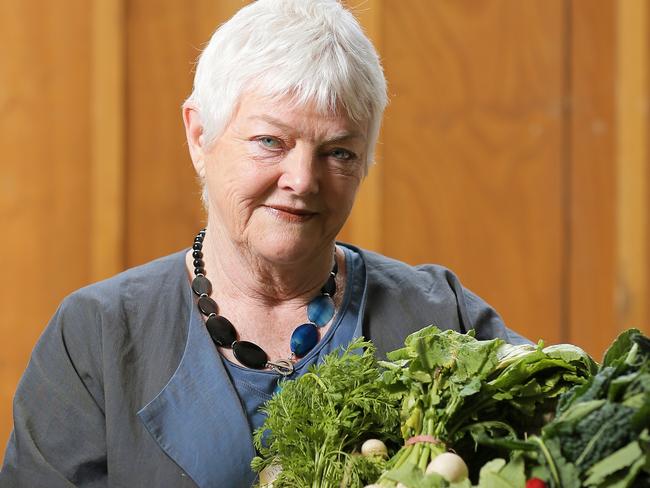
JAMIE Oliver calls her a “true food hero’’, while Nigella Lawson, another friend, prizes her “noble modesty’’. But it’s Alexander’s impact on fellow Australians that really matters and,
on that score, this author and educator is in a league of her own. Alexander’s legendary restaurant Stephanie’s set new culinary standards over 21 years. Her 1996 book The Cook’s Companion is known as Australia’s “food bible”. And the Kitchen Garden Foundation she established in 2001 continues to inspire children to grow and cook food.
What does Melbourne food mean to you?
“A truly extraordinary city combining diversity of style and price points in its fresh food markets as well as in its restaurants and cafes. I love the fact that whenever I visit an unknown (to me) area I find a food culture alive and well, with quality produce. No one needs to
be eating sliced white bread anywhere in this city.”
What do the next 25 years hold?
“There will always be a place for comfort-driven restaurants that are truly welcoming and restorative versus those that opt for pumping music, hard surfaces and dishes that are often influenced by global media.”
What’s holding the industry back?
“Maybe there are too many establishments all competing for the same customers. I would like to encourage our talented young chefs to reflect on their own influences and where they are in the world in order to develop a personal style.”
WILL STUDD
Cheese specialist
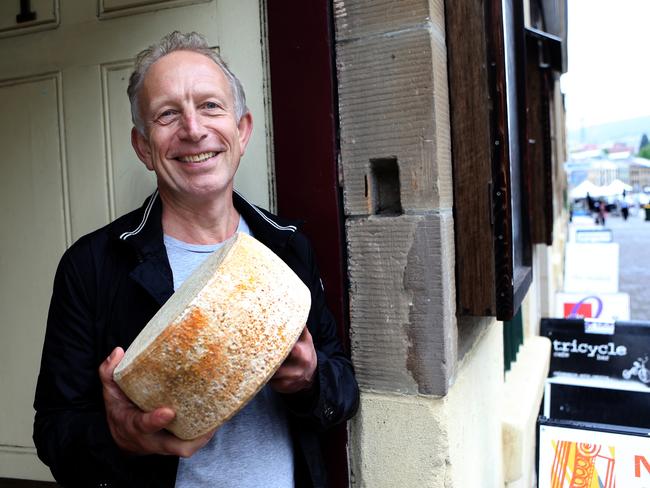
SAY cheese and Studd springs to mind. That’s because this UK-born entrepreneur and educator has long been its greatest champion. Through shops, books (Chalk and Cheese) and TV (Cheese Slices), Studd has talked up the glories of specialist cheese and championed cheese made from raw milk. Officialdom in Australia refused to let unpasteurised cheeses such as roquefort into the country “until Studd brought pressure to bear. But he credits consumers with leading the “revolution in the production and sale of artisan and farmhouse cheeses’’.
What do the next 25 years hold?
“The Australian dairy industry will continue to be driven by international demand for commodity cheese and milk powder. The size of dairy herds will expand and the number of small farms will shrink. Specialist cheesemaking will become vitally important in ensuring endangered family farms do not become extinct.”
What’s holding the industry back?
“National food regulations — and overzealous state bureaucrats — have ensured it is almost impossible for specialist cheese makers and mongers to operate on a similar basis to their successful counterparts overseas. The strict standards applied to the production and sale of cheese made from unpasteurised raw milk are incredibly embarrassing on the global stage. It’s amazing that the only raw milk cheese sold here (under current FSANZ definitions) is roquefort.”
MATT BAX
Hospitality entrepreneur
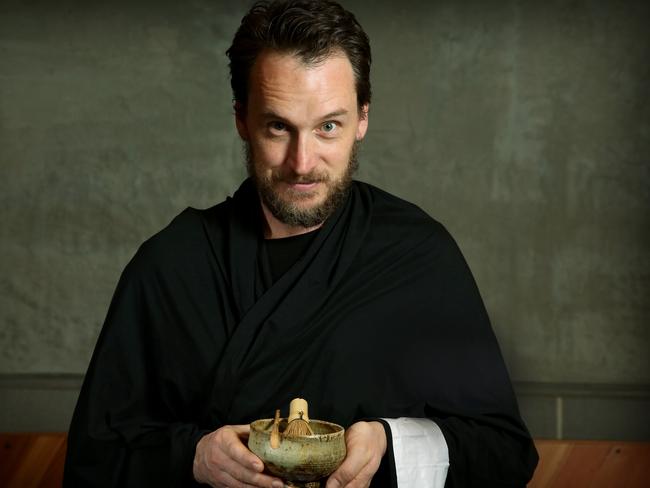
“I WANT to be constantly challenged,’’ Bax says. That explains things. Why else would he have opened, then closed Richmond’s much-admired bar Der Raum? Or tried to make money from Bar Americano, a CBD laneway bar only big enough for 10 people. Or turned his attention to tea? Bax’s Samu bar, unveiled last year at Andrew McConnell’s Supernormal, honours matcha, Japan’s trendy ground green tea powder. But Bax — an artist before he became a hospitality entrepreneur — would like “the industry’’ to encourage guests to move around more. “A wine here, a beer there and a cocktail in another place. I think that makes for a more interesting night out.’’
What does Melbourne food and drink mean to you?
“We have one of the most diverse food and drink scenes in the world. It means Dan Hunter’s parsnip dessert (at Brae in Birregurra), amazing dumplings in Chinatown, a faultless coffee at Dukes, a beer at the Lincoln, mouth-watering bread at Embla — washed down with cheeky natural wine — or a perfectly mixed classic drink at The Everleigh.”
What’s holding the industry back?
“Staff. There’s been a big shift in the attitude of younger workers. People jump around too much, they don’t spend enough time to learn the subtleties of the trade. I probably sound like a grumpy old man but there just isn’t the work ethic we once enjoyed in this industry. There appears to be a very low tolerance to pressure. A kid has a bad day and they just walk straight into another job. Back in the day, that same kid would grit it out and be better for it. You are never going to excel in anything if you quit the minute it gets tough.”
PETER CRINIS
Hotelier
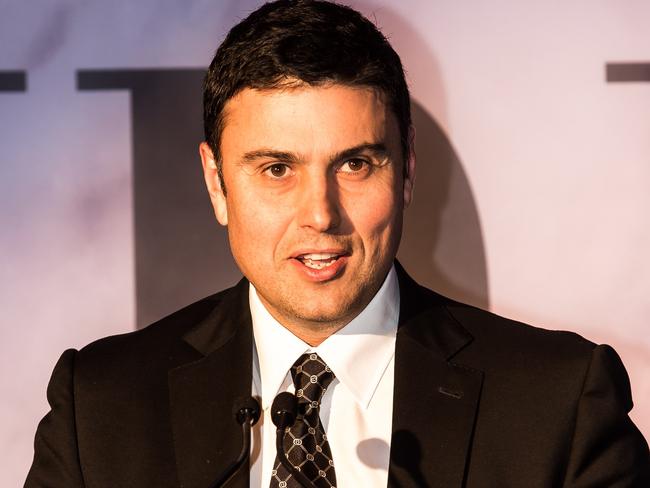
“I’M going to shut the Fat Duck and bring it here to Melbourne. We’re going to pick up the Fat Duck, the whole team and fly them over here. Then we’ll run for six months, return to the UK but in the same space the Duck occupies, we’ll leave behind a permanent restaurant, Dinner by Heston Blumenthal.” With those words one of the world’s biggest chefs made Melbourne the most famous food city on the planet. And in the background was Crinis, Crown Melbourne’s head of hotels, food and beverage, who was instrumental in pulling off one of the biggest restaurant coups in Australia. But it’s not just Heston drawing crowds to Crown. There’s a full suite of restaurants — from Bludso’s BBQ to Neil Perry’s Spice Temple, Nobu’s sushi and 400 Gradi’s pizza, plus the best Thai around at Long Chim — making this one of the best places to eat in town.
Most memorable dish from the past 25 years?
“Costilla con sobrasada (roast lamb cutlet with Catalan pork pate) at the original MoVida.”
MASTERCHEF JUDGES
TV food royalty

THEY’RE known by their first names, are mobbed by fans from Mentone to Mumbai and introduced the concept of “plating up” to dinner tables across the land. It’s hard to overstate the impact MasterChef Australia and judges George Calombaris, Gary Mehigan and Matt Preston have had on our dining habits since they burst into our homes in 2009 with their family-friendly food competition that had real heart and cooking smarts. The show is now filming its ninth season. When not filming, Preston pens columns for delicious and the Sunday Herald Sun’s Stellar magazine and has authored four cookbooks; you’ll find Mehigan at his popular Boathouse
in Maribyrnong; while Calombaris’s mission to serve great Greek food continues, at his Jimmy Grants souvlaki bars, Hellenic Republic restaurants or modern fine diner Press Club.
Most memorable dish from the past 25 years?
Calombaris: “Teage Ezard’s crispy pork hock ... a good representation of multiculturalism and local produce — so delicious.”
Mehigan: “Meredith lamb, sheep’s milk yoghurt and lamb’s lettuce at Greg Brown’s Browns Restaurant in Armadale. It was a trailblazer in the early ’90s, long before regionality and provenance were buzz words.”
Preston: “The revolutionary pizzas at Templestowe Espresso and i Carusi.”
What’s holding the industry back?
Calombaris: “Hospitality is the biggest industry in this country. It employs the most people and it needs constant support, guidance and care. We have become a 24 hour/7 days a week industry that requires government support consistently to make sure it thrives, the industry continues to create jobs, and we make sure customers regard our industry in Australia as the best in the world.”
Mehigan: “The value we place on food and service has to change, we should not expect to pay a $1 for a litre of milk or a loaf of bread. Nor should we be surprised that a daily latte cost us more than we expected. It’s a luxury we should remember that our grandparents could have only dreamt of.”
Preston: “The growth of chain restaurants — both large and small — with their inferior, mass-produced food. These places also further crowd an already oversupplied market making it harder for the places by people with real passion (rather than the pursuit of gouging profit) to survive.”
BEN SHEWRY
Chef/restaurateur

WITHOUT over-egging the pudding, if it wasn’t for Shewry, the World’s 50 Best Restaurants awards would not be held in Melbourne this week. Shewry’s Ripponlea restaurant Attica is the only Australian inclusion on the current list — and it’s been a staple on the zeitgeisty awards since its first listing in 2013. So we have a Kiwi chef to thank for flying the flag for Australia — and Melbourne — on the world stage. He’s universally regarded as one of the nicest people in the game — and one of the brightest. Having bought out his business partners, Shewry
is now truly master of his domain. A refresh of the dining room has injected new life into
the moody space where the multi-course menu that’s equal dash wit, whimsy and wonderful storytelling is served for diners who snare a coveted table.
Most memorable dish from the past 25 years?
“Chef Andrew McConnell’s confit apple dessert at Diningroom 211 in 2003.”
What does Melbourne food mean to you?
“For me it’s the way we celebrate our cultural diversity; people are eating the cuisine of people that migrated here through time and made this city the incredible place that it is. And almost all of these different cultures are represented in a uniquely Melbourne way with sensitivity and integrity.”
What’s holding the industry back?
“That more hospitality workers aren’t opening their own places without business partners or backers. In the last 10 years there’s been more of a shift towards restaurants opened by faceless groups and I’d like to see more hospitality workers owning their own places outright and taking more risks.”
CHRIS LUCAS
Restaurateur
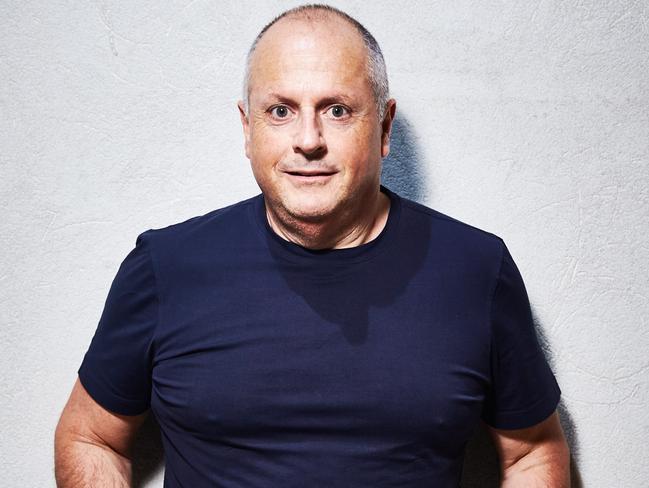
YOU need only to see the queues along Flinders Lane to note the impact Lucas has had on our dining psyche. Only a restaurant like Chin Chin, the phenomenon that heralded the reservation-free restaurant, could still pull locals and tourists in such force while celebrating its sixth year. Then there’s his Korean restaurant Kong, the beer-hall style of Hawker Hall and the Melbourne-Italian brio of Baby. From One Fitzroy St in St Kilda to The Botanical Hotel in South Yarra in its heyday, Lucas has been a towering presence on Melbourne’s food scene. Next? Another Kong in Collingwood, a high-end Japanese in Flinders Lane, and exporting Chin Chin to Sydney.
What does Melbourne food mean to you?
“Integrity. It’s a city that celebrates genuine talent and restaurants that have depth and
sit above trends.”
Most memorable dish from the past 25 years?
“Paul Wilson’s Warm poached egg with truffle and soft polenta at The Botanical. One the most original, delicate and beautifully balanced dishes ever created in Melbourne.”
ALLA WOLF-TASKER
Hospitality legend
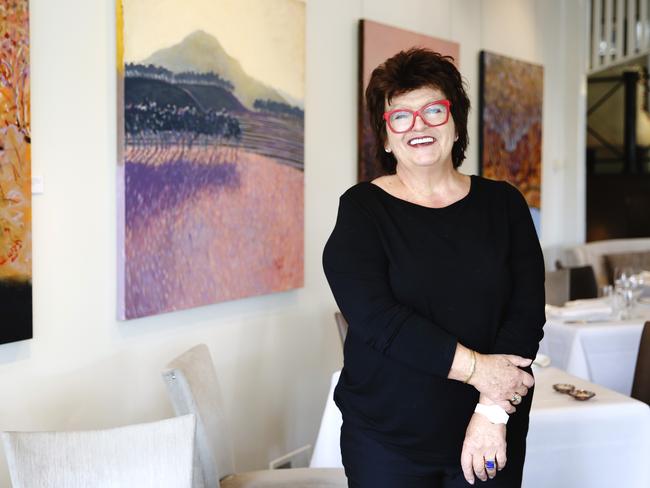
LONG before foraging was fashionable and we gave a hoot about where our food came from, foodie force Wolf-Tasker waved her pompoms for ethical, sustainable, local and seasonal produce. She and artist husband Allan transformed a treeless site in Daylesford more than 30 years ago into the upmarket lakefront retreat known today as Lake House. She’s widely credited with putting regional destination dining on the map and her award-winning dining room remains one of our best restaurants, where country-style hospitality meets refined, unfussy food. When not running her cooking school or hosting masterclasses, producers’ days and events with star chefs, she’s flying the flag for small-scale producers or mentoring hospitality talent.
Next big thing in Melbourne’s food scene?
“Melbourne’s restaurant audience has grown beyond waiting breathlessly for TNBT. Melbourne foodies are savvy and discerning travellers. Yes, they’ll always be curious, but they know what they like and are super appreciative when they get it.”
What’s holding the industry back?
“All of us struggle with skill shortages. It’s been an ongoing battle for some years now with the lack of supply of appropriately qualified people for our ever-expanding industry. We need some solid planning and thinking put behind the issue.”
What does the next 25 years hold?
“Global culinary thinking already moves and is communicated with lightning speed. And this will only increase. Where once we waited for cookbooks to arrive from overseas, social media now affords us a daily look at the world’s tables dish by dish. A double-edged sword for the industry perhaps? New thinking is always necessary and fuels inspiration but chefs will need to hold onto their own food philosophy and direction lest a global sameness overtakes us all. I, for one, do not want to see an endlessly repetitive approach to cooking and presentation on tables in Copenhagen, Sydney, Paris and NYC.”
ANDREW McCONNELL
Chef/restaurateur
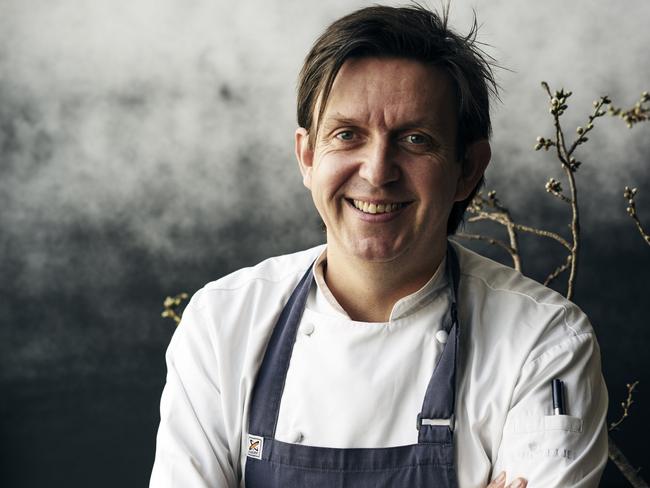
McCONNELL has nine bars, bistros, butchers, fine-diners and cafes in inner Melbourne. For any other chef, it might be quantity over quality, but each new venue seems to raise the bar. After head chef stints in London, Hong Kong and Shanghai, McConnell opened Diningroom 211 in Fitzroy in 2003, followed by Three, One, Two in Carlton before Cumulus Inc on Flinders Lane in 2008. Today, there’s sister bar Cumulus Up, renovated Fitzroy fine diner Cutler & Co and adjoining wine bar Marion, The Builders Arms pub up the road and its Chinese restaurant Ricky & Pinky, pan-Asian city kitchen Supernormal, St Kilda bistro Luxembourg and high-end butcher Meatsmith. He has none of the desire for fame a la Manu, Curtis or Guy, just a freakish knack of knowing what we want to eat next. Lobster roll, anyone?
Where do you want to eat next?
“I’d like to dine out more in the outer suburbs such as Springvale, Footscray, Oakleigh, Box Hill and Dandenong. They’re all exciting and crucially significant food destinations.”
Most memorable dish from the past 25 years?
“Suckling pig at the Flower Drum springs to mind, as does the truffle pasta at Grossi Florentino. That being said, I recently had a groundbreaking toasted raclette sandwich at the Prahran Market.”
NATHAN TOLEMAN
Cafe specialist
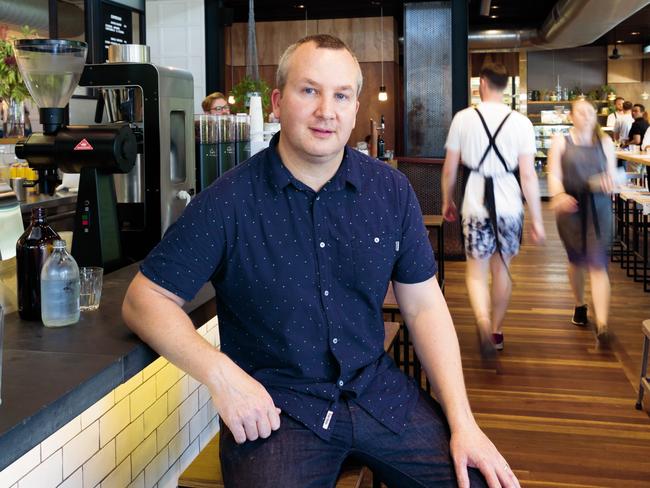
TOLEMAN was one of the first to make communal tables a must and turn concrete shells under new apartment blocks into welcoming hangouts. He made cafes the new nightclubs when it came to queuing. A 90-minute wait was the norm when his Richmond cafe Top Paddock opened in 2013. He also harnessed social media to promote his menu, such as the Insta-famous ricotta hot cakes with flowers and fruit. Toleman’s Midas touch started in 2006 with Apte in Alphington with chef wife Sarah Foletta. Going on to open Liar Liar in Hawthorn, Abbotsford’s Three Bags Full and Two Birds One Stone in South Yarra (all since sold), the father of four — with various business partners — now runs Top Paddock, The Kettle Black in South Melbourne and the city’s Higher Ground, which has transformed an 18th century power station with 15m ceilings into arguably one of the country’s best cafes.
Next big thing in Melbourne’s food scene?
“House-made spirits, more snack-focused menus and a move away from fussy, tricked-up food to cleaner, simpler flavours. More excellent regional venues opening within an hour from Melbourne where rents are cheaper and access to produce easier. All-in-one dining destinations where food is grown, prepared, served and then composted — all on-site — meaning a complete closed loop.”
What’s holding the industry back?
“That fact that many people still don’t acknowledge that working in the hospitality industry is an honourable profession and a long-term career with growth potential. Not enough good experienced chefs and young, passionate waiters are looking for a long-term career. Also, diners wanting free-range, organic and traceable produce but not being aware of the costs associated with this.”
SIX DEGREES
Architecture firm
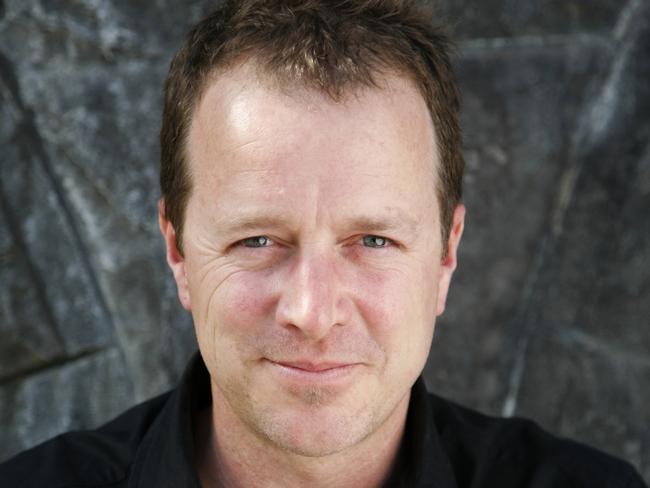
BEFORE Six Degrees’ pioneering projects put hospitality architecture on our radar, the average latte lover didn’t necessarily care about cafe and bar fit-outs. But today, along with the rise of social media, cool, cutting-design or different design has become an important ingredient in boosting venue profiles. One of Six Degrees’ first gigs was in 1994 in Meyers Place,
a European-style CBD bar recognised as revolutionising Melbourne’s laneway culture, while at Balaclava’s Wall Two 80 cafe, it installed one of the city’s first windows serving the street. In 2006, it was tasked with transforming derelict bluestone vaults under Federation Square into the Riverland Bar before turning a historic shed and boardwalk space into the Boatbuilders Yard bar and kitchen down the river at South Wharf. Mark Healy, one of the company’s six directors, says a unique “Melbourne style” has evolved. “Think white brick tiles, distressed brickwork, white marble slabs, recycled hardwood, raw welded steel, industrial light fittings, textured glass and exposed plywood joinery, though it’s hard to say what is truly Melbourne any more.”
Most memorable venues from the past 25 years?
“We still love Pellegrini’s on Bourke St. It’s never been renovated because it was so brilliantly designed in the first place. It doesn’t care about fashion and has now reached institution status. It had a “chef’s table” in the kitchen long before Heston was born. I also really like Hell’s Kitchen upstairs in Centre Place in the city. It feels like you’re in the film Blade Runner or a William Gibson novel.”
What does the next 25 years hold?
“No idea, but I hope restaurants start taking bookings again.”
KATHLEEN QUEALY
Award-winning winemaker
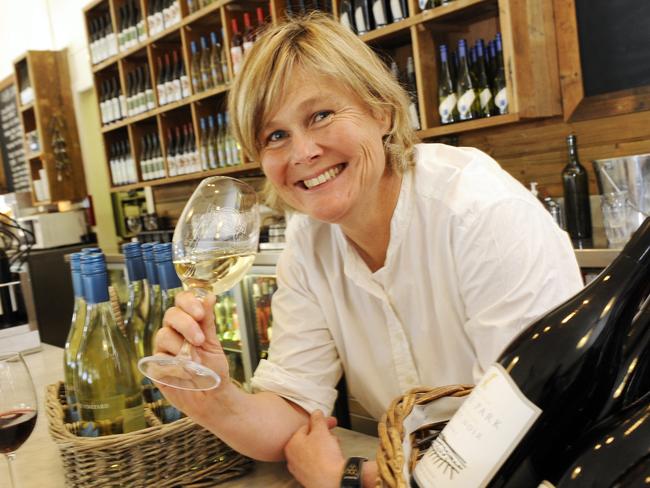
WITH hundreds of wineries and vineyards across Victoria, we have never had more wines to choose from. But in the rush to cellar doors, to taste diverse, regionally expressive drops, it’s easy to forget people are labouring behind the scenes. People like Quealy. This winemaker made her name in the 1990s with the T’Gallant label on the Mornington Peninsula and played a big role in popularising pinot grigio. Today, as chief winemaker at Quealy Winemakers in Balnarring, she champions a range of styles and sets the highest industry standards. Last year, Wine Communicators of Australia anointed her Legend of the Vine.
What’s holding the industry back?
“Victoria’s wine industry is intimately entwined with restaurants. I think tax, specifically GST in restaurants, stifles the necessary profitability and risk-taking that we need to reinvest to make our industry vibrant.”
What do the next 25 years hold?
“It will be influenced by market wishes for more organic (wines), minimal intervention, beautifully crafted naturally made wines. Regions will specialise in the varieties they do best. I think, and hope, the demand for regional, ‘hands on’ winemakers will continue to grow.”
RAPH RASHID
Food truck prince
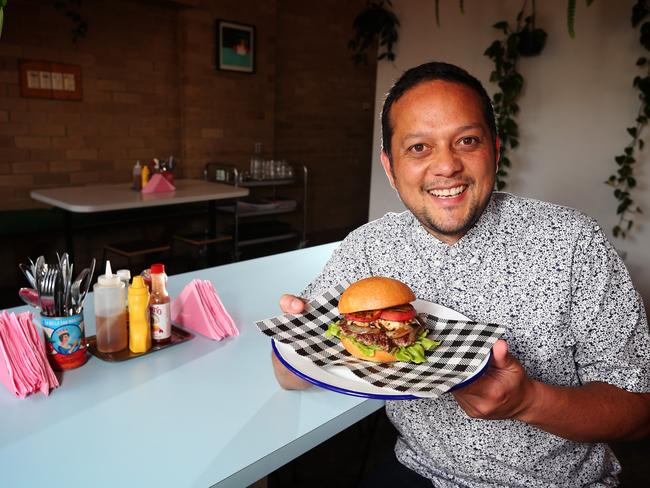
MEALS on wheels has taken on a whole new meaning thanks to this man. After his Beatbox Kitchen van — pimped up like a mobile boom box — debuted at the Meredith Music Festival in December 2009, our love affair with eateries of no fixed address was jump-started. Inspired by Los Angeles’ food truck scene, Rashid followed his Beatbox burgers with Taco Trucks cruising the inner city, fans hitting social media to learn their locations. Today there are scores of mobile businesses serving up everything from sliders, jaffles and gourmet toasties to bibimbap, German sausage and Greek doughnuts, as well as dedicated food truck precincts. In February, Rashid opened a 40-seat Beatbox Kitchen in Brunswick. He also owns All Day Donuts, Brunswick
diner Juanita Peaches and catering company Good Hustle.
Where do you want to eat next?
“I gotta get to Igni in Geelong. I also want to eat as much pizza from Shop 225 and gelato from Miinot (both in Pascoe Vale South) as I can. More and more great food is pushing out into the suburbs and more obscure areas.”
JENNIFER HIBBS
Market leader
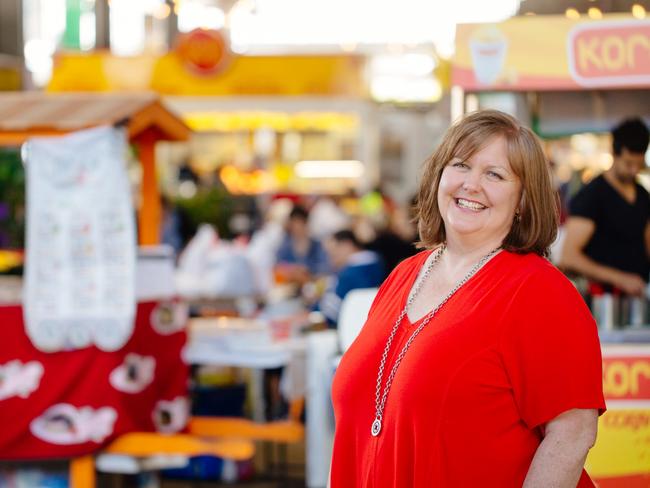
HIBBS was a 21-year-old arts graduate when she started as a receptionist at the Queen Victoria Market in 1985. She left 27 years later as CEO. In between she held the roles of leasing manager and chief operating officer, overseeing the restoration and conversion to retail of near-derelict shops at the 138-year-old market, as well as refurbishment of the Meat Hall and restoration of the Art-Deco Dairy Hall. She was also instrumental in setting up the summer night markets, steered QVM to several tourism award wins and initiated the Geelong and Coburg night markets in 2009 and 2010. After 5½ years at the helm of QVM, Hibbs joined the Dandenong Market in her current role as general manager.
What does Melbourne food mean to you?
“We love eating out, we love buying food, we love cooking and experimenting with it in our homes and in our restaurants. Melbourne is a food lover’s city. It’s etched in our DNA. I once heard Melbourne described as a European city with Asia’s love of food. I think that’s very apt.”
What does the next 25 years hold?
“The great thing about our food culture is that it’s not constrained by boundaries, rules and traditions — it’s just a fusion of a whole lot of influences from the many countries and cultures we come from or places we’ve visited. Over the next 25 years, I think we’ll see a lot more food influences from North African and the Middle East as our palates are woken up to those cuisines through a shift in our demographic and awareness. I think there’ll also be a continuing growth in Asian influences (especially subcontinent) for the same reasons, rather than anything out of Europe.”
PETER CLEMENGER
Melbourne Food and Wine Festival founder

IF one person can take credit for establishing the MFWF 25 years ago, it is Clemenger. Alarmed at Victoria’s sorry state in the early ’90s, this visionary advertising man imagined festivals capitalising on the state’s strengths: food and drink, gardening and fashion. “The thing is, I couldn’t make fashion work and I didn’t know much about gardens,” he says. “So I thought, food and drink ... that’ll do. Let’s celebrate that.’’ The response was not wildly enthusiastic. The first MFWF in 1993 had 12 events, and one — a World’s Longest Lunch at the MCG — struggled to sell 400 tickets. Today, MFWF is a signature cultural event, attracting the world’s best chefs and hundreds of thousands of people.
What does Melbourne food and drink mean to you?
“The change has been extraordinary. We’ve grown up. Just look at the amount of outside dining now. I remember a time when you hardly ever saw a cafe table on the pavement.’’
JOHN NIEUWENHUYSEN
Liquor reformer
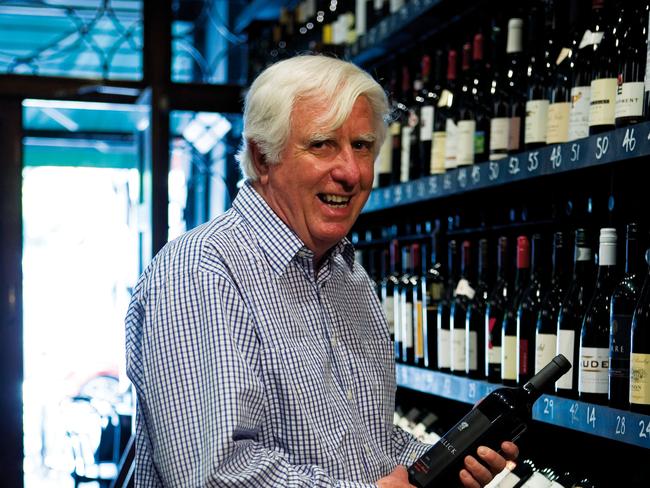
IMAGINE a city where you could break the law just trying to get an alcoholic drink with your meal. That was Melbourne in the 1960s and ’70s. “The drink laws were truly antediluvian,’’ says Nieuwenhuysen, who arrived in Australia in 1963. The wowserism endured into the 1980s, when Nieuwenhuysen, a university economist, delivered a visionary report advocating changes to Victoria’s antiquated licensing laws. The Cain government answered this call with liquor reform legislation in 1988, sweeping away “old and unnecessary restrictions” and opening the door to new laneway bars, wine shops and winery restaurants. “Never in my boldest imaginings did I visualise the remarkable transformation that occurred,” he says. “Melburnians are now able to be far more outgoing, eating and drinking outside their homes in a way that puts them on a par with refined European cities such as Vienna, Amsterdam
and Rome.’’
What do the next 25 years hold?
“I am confident the vital, entrepreneurial and innovative (hospitality) industry will go from strength to strength. The tendencies for Australian households to drink and eat out will rise. But authorities will become increasingly concerned with public disorder from large-scale nightclubs and events, and will seek to limit access to alcohol in danger spots.”
CON CHRISTOPOULOS
Restaurateur
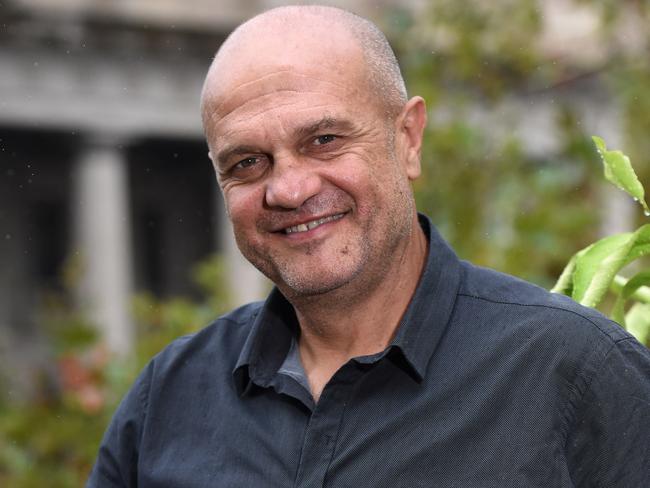
“I JUST want to create good spaces,’’ says Christopoulos. Starting with Cafe Segovia in the early 1990s, he has opened some of Melbourne’s most sociable eating and drinking spaces — the European and the City Wine Shop, Supper Club and Siglo, Kirk’s Wine Bar and Neapoli, to name a few. What connects them is consistency, conviviality and a raffish Euro vibe. But Christopoulos — who likes to surround himself with “good people’’ — is too highly strung to ever rest on his laurels. As he says, “I’m addicted to the creative side of it ... I assume I’ll be opening one new venue every year for the rest of my life. Why not?’’
What do the next 25 years hold?
“Healthy eating — nearly every good restaurant now has a handful of ‘clean’ dishes on the menu — and less consumption. Can’t remember the last time I sat down and had a whole steak to myself.’’
What does Melbourne food and wine mean to you?
“Eating out is a much broader part of everyone’s lives. I eat out 95 per cent of the time, that’s been the trend for me, and I feel healthier and more excited than ever before.’’
TONY NICOLINI
Artisan pizza pioneer

HE grew up “between flour and tomato’’ in his father’s modest pizzeria. Decades on, Nicolini
is steeped in Melbourne’s Italian cuisine at the helm of an expanding pizza empire. The D.O.C. Group, which he co-owns, has a foothold in Carlton, Albert Park and Mornington and seeks to put “people before profits’’. “It’s not just about providing exceptional food. We now need to provide social playgrounds and experiences that are accessible on a daily basis,’’ Nicolini says. D.O.C. has also sought to lift service standards and forge closer relationships with suppliers. But Nicolini’s efforts to advance “artisan pizza’’ in this town rank perhaps as his greatest achievement. Others blazed a trail, of course, notably Pietro Barbagallo at i Carusi in Brunswick. but D.O.C.’s trick has been to take the idea of thin, crispy pizzas “done with heart’’ to a wider mainstream audience.
What does Melbourne food and drink mean to you?
“A melting pot of very good food, produce and design. Melbourne food is gaining momentum, with increased competition and better educated consumers.”
What do the next 25 years hold?
“The simplicity, accessibility and affordability of Italian food will solidify its position in Melbourne. We will see more local Italian producers, a push towards sustainability, strong consideration for organics, and more healthy alternatives as we dine out more frequently. We have exceptional raw material that requires Italian ingenuity and “bravura” to elevate. The focus will be contemporary with upmost respect for tradition.”
MAZ SALT
Owner/operator

WHO said you needed proper seats in a pub? Or even walls? Salt dispensed with both when he opened Section 8 in 2006. The one-time barman put two shipping containers on a carpark site in Chinatown and the improvised space was an instant hit. Section 8 still prospers in Tattersalls Lane and Salt continues to galvanise Melbourne’s laneway culture with lively new late-night spaces. Belleville, Ferdydurke and The B. East all bear his stamp. But don’t be fooled by their apparent ready-made quality. Behind the scenes, at his Office of Public Works, Salt makes sure everything runs to plan.
What’s holding the industry back?
“Hurdles for the industry include the growth of retail malls that divert pedestrian traffic away from local traders and licensing regulators who often don’t appreciate the urgency inherent in small business. But generally speaking, we have a vibrant marketplace that is the envy of many.”
What do the next 25 years hold?
“We seem to assimilate trends and influences faster and more comprehensively than many other places in the world. So it would be a brave person indeed who could predict the future beyond 2018. I believe that more vegan foods, meat substitutes and the technology revolution have yet to really make their impact.”
SAHELY FAMILY
Café owners
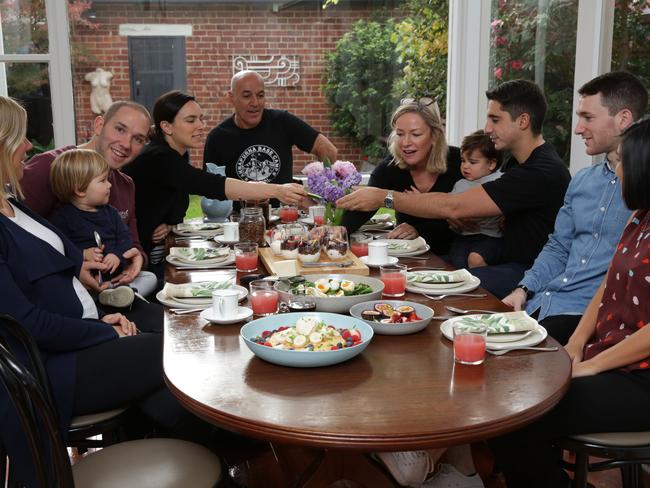
IF you’ve sat down to a superfood salad at breakfast, tried peanut butter and tomato on toast for lunch or queued for a lobster doughnut burger, thank the Sahely family. The family
is the brains behind some of Melbourne’s best cafes — from Pillar of Salt in Richmond, which opened in 2010, to Bawa in Hawthorn and Armadale’s hit Mammoth — and has created some of Melbourne’s most iconic brunch dishes in the process. While the family has moved on from Pillar of Salt and its next venture Touchwood (in Richmond), brothers Matt and Kael are about to launch Vacation Coffee in the city and along with dad Elias own and run Bawa; sister Loren and husband Jamie McBride are behind Armadale’s Mammoth, Northcote’s Primo and South Yarra’s Gilson on Domain Rd, while Kael is co-owner of Square and Compass in East Melbourne.
Most memorable dishes from the past 25 years?
Kael: “Kibbeh nayeh at Abla’s, pigeon bisteeya at MoMo, grilled prawns at Bar Lourinha, raw tuna with goats cheese and peas at Cumulus Inc.”
SAND HILL ROAD
Modern publicans
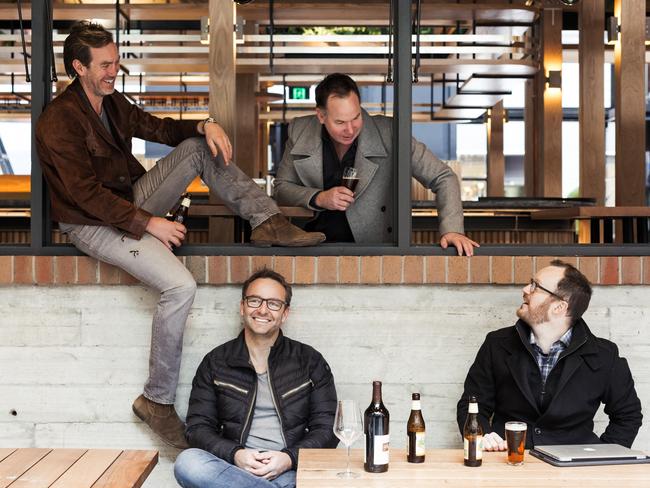
“NO one had done a large-scale pub in the city. We wanted to create a small-format public bar on a large scale,” says Andy Mullins, a quarter of the Sand Hill Road group that’s made its mark on Melbourne’s pub scene over the past 17 years. The latest, Garden State Hotel in Flinders Lane, is a 900-capacity, multi-level pub that’s taken Sydney scale and transformed it into a Melbourne offering where cold Carlton Draught sits comfortably next to yuzu-dressed kingfish, and suits next to thongs. Saving old-school pubs from becoming development sites through old values and design vision, the group has cemented itself as a big hospitality player. The Terminus (Abbotsford), Bridge Hotel (Richmond), Holliava and Richmond Club Hotel have been joined by the Prahran Hotel and Garden State. There are five more venues in the pipeline for the group — brothers Andy and Matt Mullins, Doug Maskiell and Tom Birch — including The Espy in St Kilda.
The best thing about Melbourne’s food and wine industry?
“I love the fact there is no real measure of ‘best of’. Man, that’s a classic Melbourne argument; Pellegrini’s? Or Longrain? Or Attica? Or Addis Abeba in Footscray? Or my local pizza?”
What’s holding the industry back?
“Nothing. Seriously. It’s one of the best cities in the world to be immersed in the food and wine industry.”
CON ANDRONIS AND GEORGE KAPAROS
Seafood suppliers
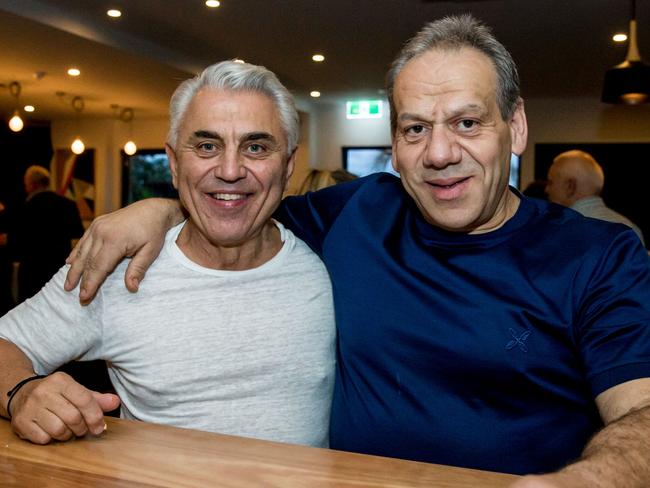
IF you’ve eaten grilled flathead, tucked into flounder or lunched on calamari at a restaurant in the past 25 years, it’s almost certain Con Andronis and George Kaparos had a hand getting it onto your plate. For three decades, Clamms has been the restaurant industry’s go-to seafood supplier. With up to 1000 venues on their books — along with supermarkets — when Victoria eats seafood it’s largely thanks to Clamms. They have also seen increasingly skilled chefs serving diners who are happy to try something new. “We couldn’t sell one kilo of calamari 25 years ago,” Andronis says. “Now anything that comes out of the water chefs want.”
What’s holding the industry back?
Andronis: “The closure of commercial fishing in Port Phillip Bay will hold the industry back as it will have a catastrophic effect on prices and availability.”
Most memorable dish?
Andronis: “The King Crab cakes at Blake’s Southgate were sensational. It is very hard to find King Crab in dishes now due to the price.”
Kaparos: “Seared wasabi tuna by John Gallagher at The Stokehouse in ’89. This dish had the perfect balance of flavours. Everything about it was amazing.”
ANDRE EIKMEIER
Wine entrepreneur
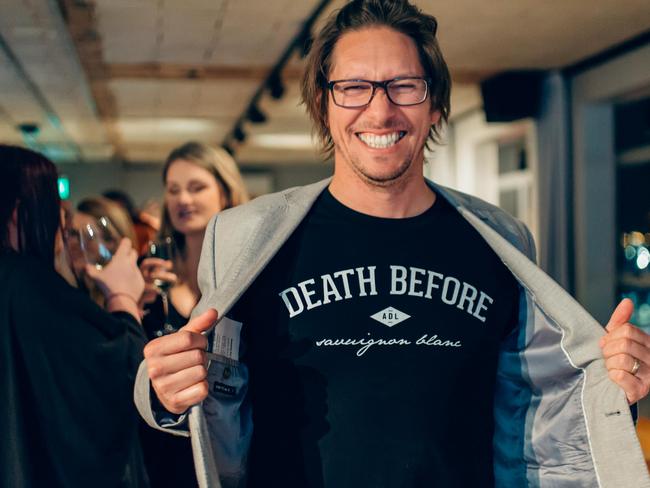
“WE wanted to be the Facebook of wine, to build a community. I had no interest in selling wine at the start,” says Andre Eikmeier, co-founder of Vinomofo, an online wine site that has since revolutionised how people buy and engage with wine. Growing out of online community Qwoff, Vinomofo has become one of the country’s fastest-growing start-up businesses in five years, and now employs 120 people at its Richmond HQ, with a Port Melbourne warehouse servicing Australia-wide orders. Last year, it sold more than half a million cases of wine, has since expanded into Singapore and New Zealand, and has China and the US in its sights.
Most memorable dish from past 25 years?
“The lamb pies at Attica blew my mind last year. They were humbly dedicated to the lamb farmer, and the crust was done with Vegemite.”
TONY ELDRED
Hospitality trainer
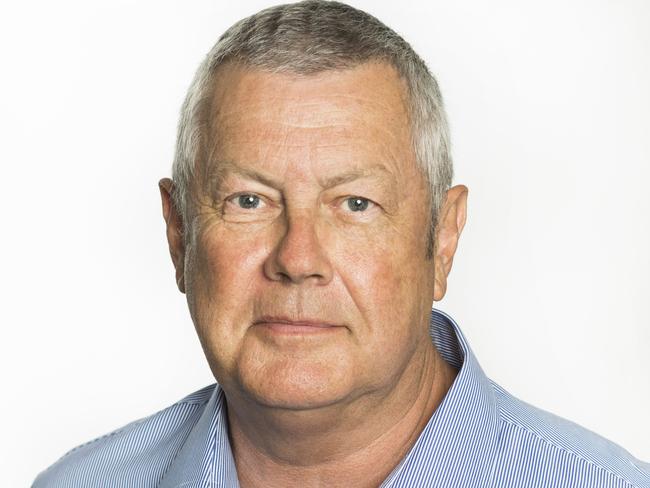
FOR 30 years, Eldred has run recruiting and management training for the hospitality industry, helping save owner-operated passion projects from going broke by turning them into profitable businesses and changing the way Melbourne’s diners are serviced in the process. He estimates more than 25,000 people have passed through his doors. “People don’t understand how complex it is to run a restaurant,” Eldred says.
What does Melbourne food mean to you?
“Diversity. We have 5500 restaurants and eateries at every market level and every conceivable ethnic cuisine.”
Most memorable dish of the past 25 years?
“Cumulus Inc’s steak tartare with anchovy oil. Hand cut, variation of a classic, done to perfection. Sometimes simple is best.”

